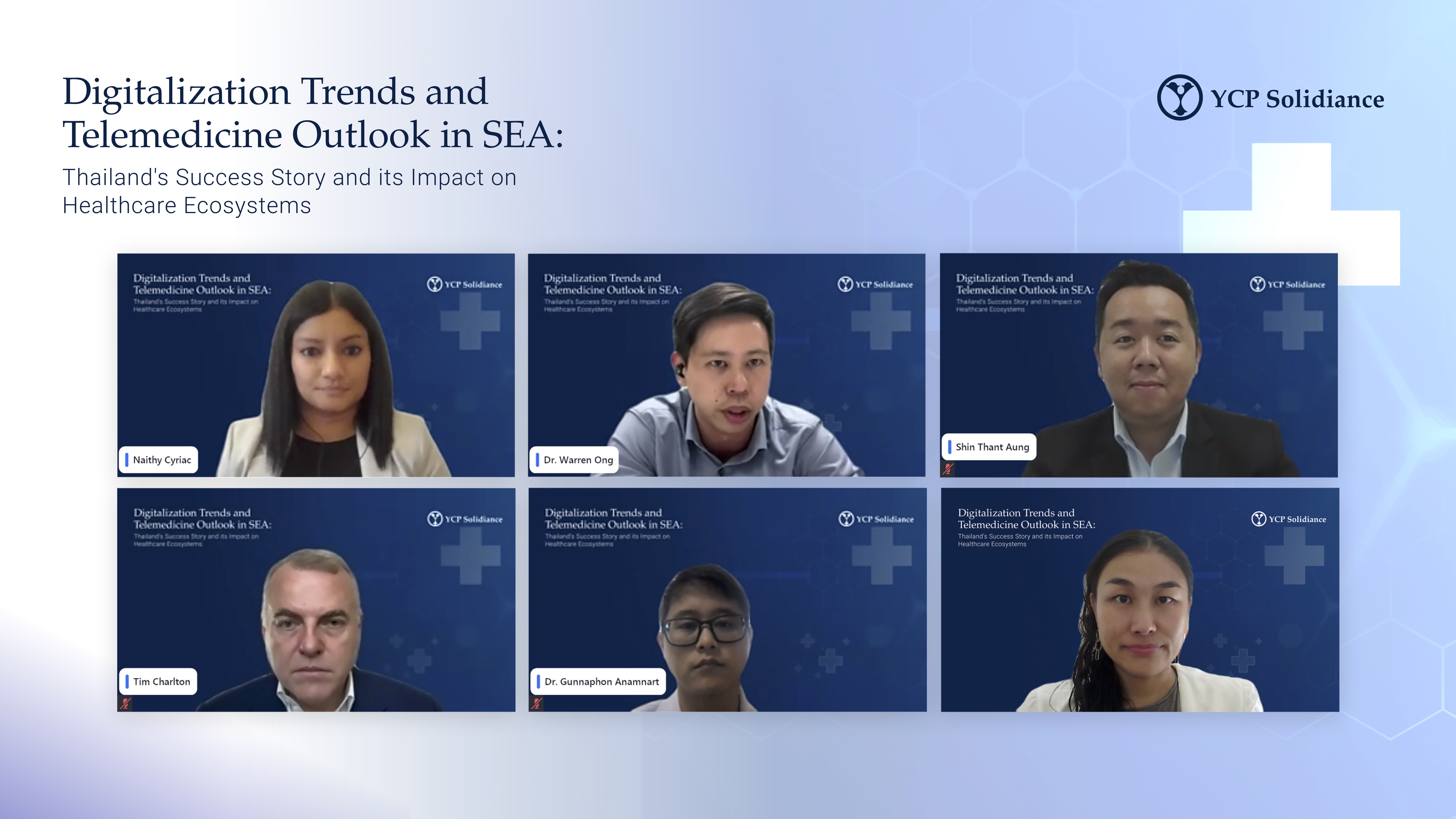Last July 6, 2023, healthcare experts joined YCP Solidiance professionals to discuss the future of the healthcare industry across Southeast Asia (SEA) through the webinar “Digitalization Trends and Telemedicine Outlook in SEA: Thailand's Success Story and its Impact on Healthcare Ecosystems.” To start off the webinar, YCP Solidiance Director Shin Thant Aung spoke on the state of healthcare in Thailand, as well as key trends that he predicts will gain adoption across Southeast Asia in the coming years.
Following his presentation was an insightful panel discussion featuring key healthcare industry experts, facilitated by YCP Solidiance Partner and healthcare sector expert Naithy Cyriac. Our experts shared their predictions on the future of healthcare across SEA, highlighting digitalization and the key issues it addresses, the varying levels of adoption, and drivers and barriers for growth.

(2nd row) Naithy Cyriac, Partner at YCP Solidiance, Dr. Warren Ong, Head of Health Services at Singlife, Shin Thant Aung, Director at YCP Solidiance
Key Trends Pushing Digital Health Transformation Forward in SEA
As the digital health transformation market is projected to grow significantly over the next few years, the panel of healthcare experts shared their experiences and learnings on how new innovative technology, such as telemedicine and mobile health applications, will continue to drive digital health transformation forward.
Dr. Gunnaphon Anamnart, Chief of the Academic Center at the Bangkok Hospital Rayong in Thailand, shared how he and his team created a new system of monitoring and categorizing COVID-19 patients using telemedicine. Even beyond the pandemic, Dr. Gunnaphon and his team continue to use telemedicine in consultations for outpatient concerns that do not involve emergency situations or require intensive physical examinations on-site. By using this technology, he and his team have considerably reduced patient waiting time.
Meanwhile, Dr. Warren Ong, a practicing doctor and Head of Health Services at Singlife, shared how many market players in the telemedicine industry are looking into innovative care models and exploring how these models can be complemented by telemedicine. This includes putting up virtual hospital-to-home programs, linking up with clinical decision-making artificial intelligence (AI) tools, and utilizing remote diagnostics. Moving forward from the pandemic, Dr. Ong believes that telemedicine adoption in Singapore will continue to grow as the government strengthens its support, increases funding, and rolls out more initiatives geared towards telemedicine.
Tim Charlton, CEO of Charlton Media and host of the Healthcare Asia Industry Forums, raised the need for healthcare providers to develop a single touchpoint. With the widespread adoption of digitization throughout the industry, many patients are looking for a one-stop-shop destination for their healthcare concerns. Healthcare providers must upskill and become digitally adept, effectively ensuring the development of a seamless telemedicine experience for patients.
Exploring Untapped Opportunities for Growth in Healthcare
Even with these key trends, endless business opportunities for parties interested in digital health transformation have yet to be tapped.
As Dr. Ong highlighted at the end of his discussion, offline and online integration will be critical in crafting a seamless customer journey in healthcare. Moreover, Dr. Ong touched on the topic of cross-country second opinions among doctors, which is tricky given that regulations for medicine and e-licensing across Southeast Asia are not uniform or transferrable. Dr. Ong stressed the need to develop a transparent three-way relationship between patients, local doctors, and international doctors to address potential concerns.
On the other hand, Charlton concluded by centering his discussion on the growing popularity of ambulatory care practice. Apart from freeing up hospital resources, he also shared how ambulatory care enables hospitals to support patient care outside the four walls of a hospital. In fact, Singapore is now opening four new ambulatory care centers. Charlton also stressed telemedicine’s vital role in monitoring patients under ambulatory care.
While the outlook for the healthcare industry across SEA is highly promising, there is still room for improvement in terms of the technology that healthcare providers across the region can implement. Healthcare providers will need to adapt to digitization to keep up with the changing needs of their market and educate their patients on innovative technologies for their benefit.
To get further insight into Digital Health Transformation and the growth of Telemedicine adoption across Southeast Asia, subscribe to our newsletter here and check out these reports:
- Digital Health Transformation and Telemedicine 2.0 in Thailand
- Utilizing AI-Driven Solutions in Finance, Healthcare, & Retail
- Digital CX (Customer Experience) in the ASEAN Market: Expansion and Challenges
